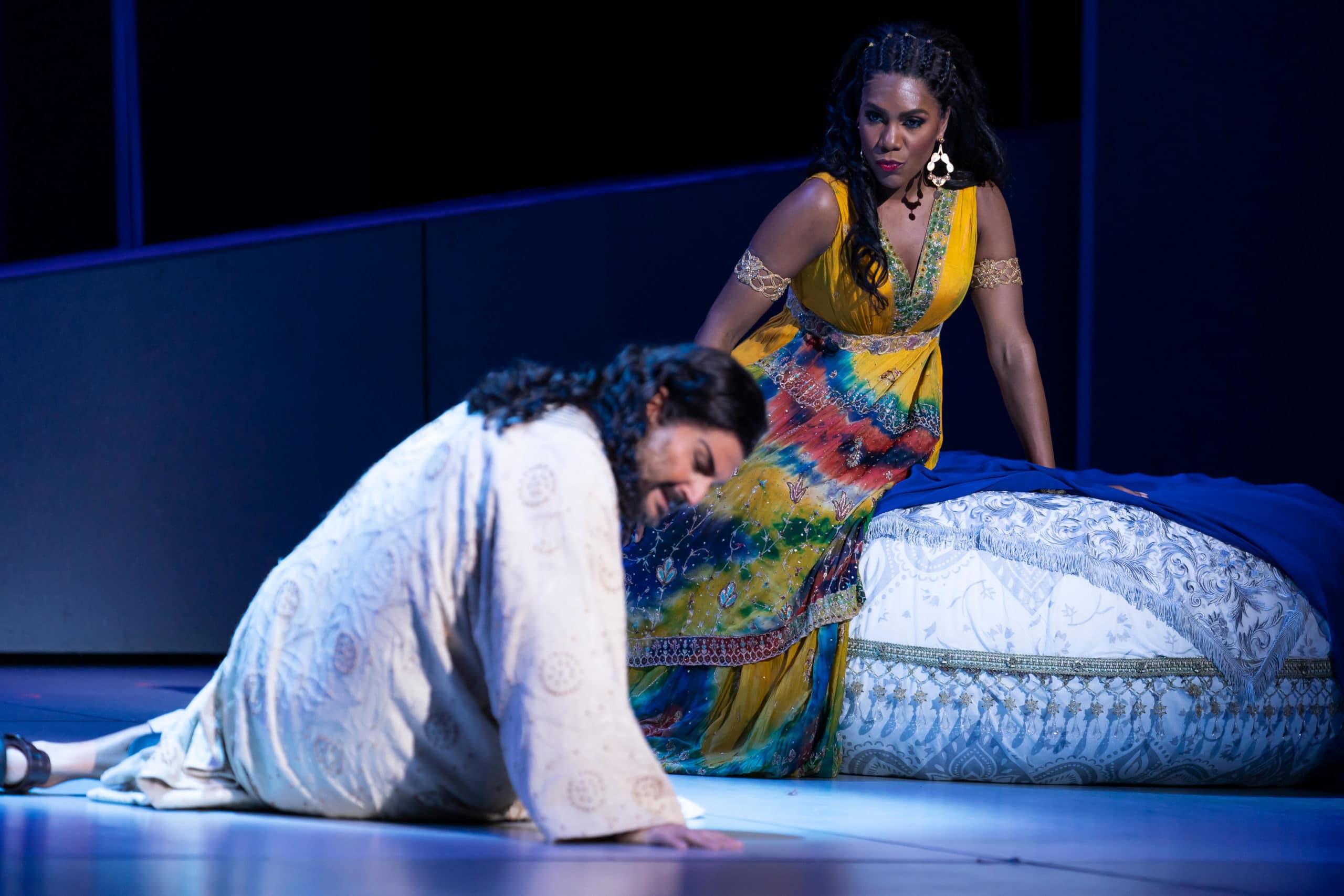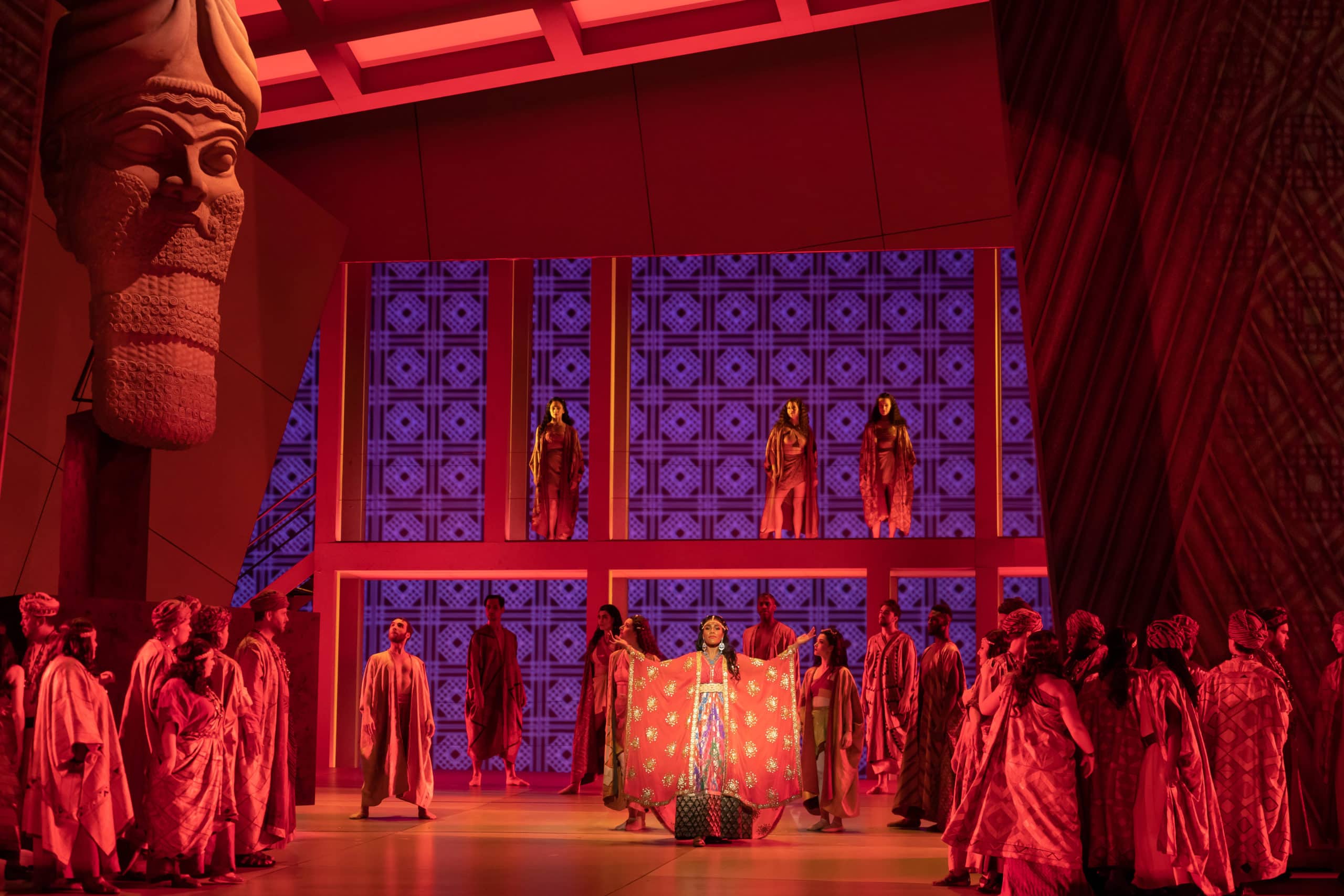Tales of wars, slaughters, betrayals, competing tribes and religions, and a few dominant women make the Book of Judges one of the more colorful segments of the Hebrew Bible. Camille Saint-Saëns and his librettist Ferdinand Lemaire saw the dramatic and musical potential of Judges’ most well-known episode: the seduction and betrayal of Israelite hero Samson by Delilah. The Washington National Opera gives its Samson and Delilah a vocally stirring and visually arresting performance.

Saint-Saëns and Lemaire give Delilah something the Bible does not: a clear motive. The Israelites and Philistines are at war. Samson (tenor Roberto Aronica), a charismatic military leader, is giving the Israelites victory after victory. As a patriotic Philistine, Delilah (mezzo J’Nai Bridges) is determined to use her feminine wiles to bring him down.
Both leads shine in their roles. Aronica has the clear, ringing, heroic tenor voice required for this popular leader, notable in his first act call to arms — “Arrêtez, ô mes frères” (“Stop, O my brothers”) — and staying strong in his remorseful “Vois ma misère, hélas!” (“Behold my misery, alas!”) in the third act.
The opera’s Samson is less the Hercules-like physical strongman of common imagination than someone whose courage and moral power inspire his people to do great things. Disregarding sage warnings from the Old Hebrew (bass Peter Volpe), Samson walks knowingly into Delilah’s clutches, forfeiting his moral authority along with his hair. The Hebrews’ disillusion with him at the outset of the third act is one of the opera’s most poignant moments.
Bridges’ Delilah is a diva. She knows it, she loves it, she flaunts it. Her power intoxicates her. It may be possible for a singer playing the role to introduce an element of vulnerability to feelings of love, but this is not a choice that Bridges makes. In the opera’s best-known aria, her beautiful, and gorgeously sung, “Mon cœur s’ouvre à ta voix (My heart opens to your voice)“, we see the character knowingly acting — utterly insincerely but very convincingly — the role of a lover. One of Saint-Saëns’ nicest moments is when, in the third act, Delilah taunts the defeated Samson, she does so with an echo of the same music. Bridges is in charge vocally, in all parts of the character’s range, and in charge physically of the demands of her role.
My only quibble with the development of the relationship between the two is in the seduction scene. The words and music are of real (on his part) and feigned (on her part) passionate, life-changing love. In contrast, their physical interaction is tentative and posed. I wished for greater heat.

Among the supporting characters, baritone Noel Bouley stands out as the High Priest of Dagon, more a political than religious leader, who is Delilah’s co-conspirator in the plot to ensnare Samson. The large chorus delivered very capably a number of powerful stand-and-sing moments, reminders perhaps of Saint-Saëns’ original concept of the piece as an oratorio. Under the direction of John Fiore, the orchestra flawlessly and expressively played the wide variety of music the composer provides.
Dance is a major element of Samson and Delilah and, if choreographer Eric Sean Vogel was intent on proving that Philistines are far sexier than Hebrews, he succeeded brilliantly. The lengthy bacchanal scene, which gives members of the excellent dance corps an opportunity to display their athleticism, can be viewed as an example of what scholars have called “orientalism,” Western fascination with depictions of the presumed exoticism and eroticism of, in this case, Middle-Eastern pagans.
The combination of Erhard Rom’s set design, Robert Wierzel’s lighting, and S. Katy Tucker’s projections creates a striking physical production. The lighting design in the first and second acts emphasizes blues and purples, with reds dominating the third act, underlining the change in mood following intermission. The seduction literally occurs on a dark and stormy night, complete with lightning flashes. On a scrim, non-representational swirls grow larger and smaller, lighter and darker. Darker or lighter clouds sweep across. As Samson laments his fallen state, ghostly projected shadows of the Hebrews appear to haunt him.
The set features sharp, almost modern, lines, including a triangular sloped platform upstage, with angled vertical panels that slide in and out. In the third act, a matrix of rectangles takes over, with stage right dominated by a large, Assyrian-ish, bust of the Philistines’ god Dagon. There is no attempt at a literal representation of what ancient buildings may have resembled. Like the lights and projections, the sets go to the emotional underpinnings of the story, and do so successfully.
Among the costumes, designed by Michael Scott and Timm Burrow, those for Delilah naturally stand out. Whether in a sleeveless yellow outfit with a blue cape in the seduction scene, or in a vivid red in the third act, the costumes accentuate the character’s dominating beauty. Samson, on the other hand, is mostly in simple white. When the chorus members are Hebrews, they have subdued, peasant-like dress. The dancers’ look in the bacchanal would not be out of place in any hot Broadway show dance number.
Director Peter Kazaras weaves the traditional storyline, costumes that suggest ancient times, and modern design elements into a fabric that ably supports the top-notch voices in the cast. It is a highly satisfying production. It is tempting to wonder, however, whether an updated concept might make Samson and Delilah an even more exciting work. It is, after all, set in Gaza, in the midst of a conflict between Israelites and another people with a competing claim to the same territory. An adventurous production might make something of that.
Running Time: Two hours, 40 minutes, including one intermission.
Samson and Delilah plays through March 21, 2020, in the Kennedy Center Opera House, 2700 F Street NW, Washington, DC. For tickets, call the box office at (202) 467-4600, or go online.




